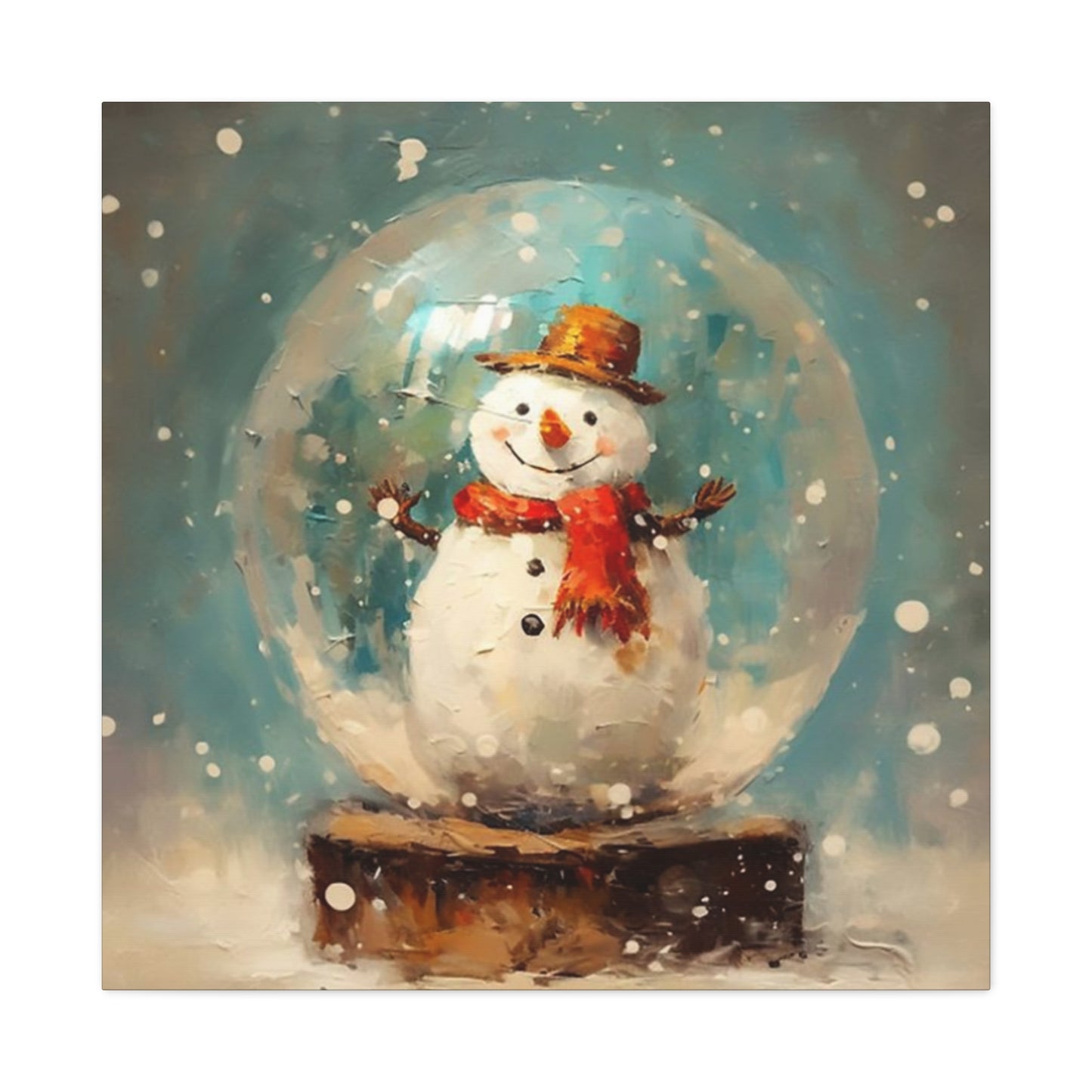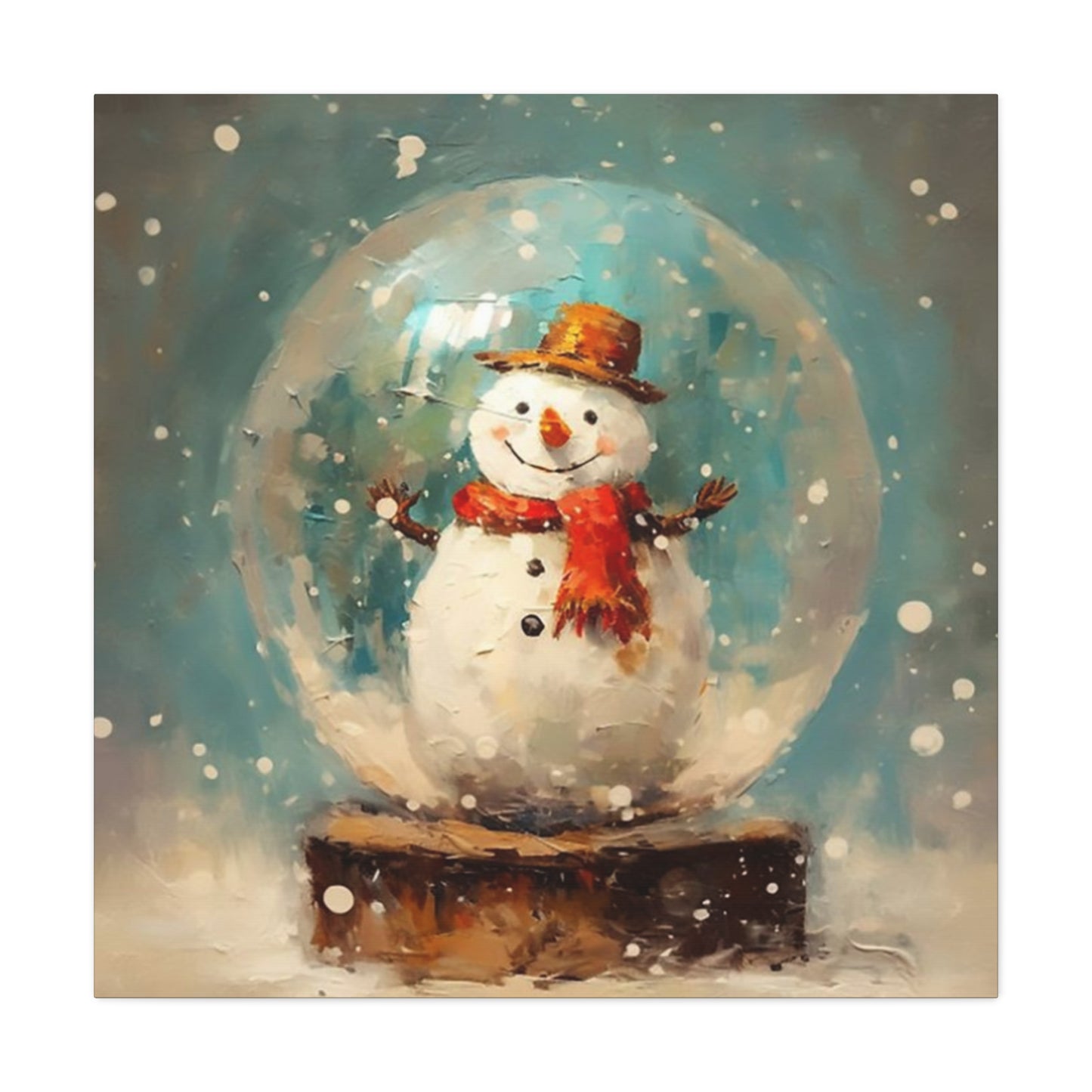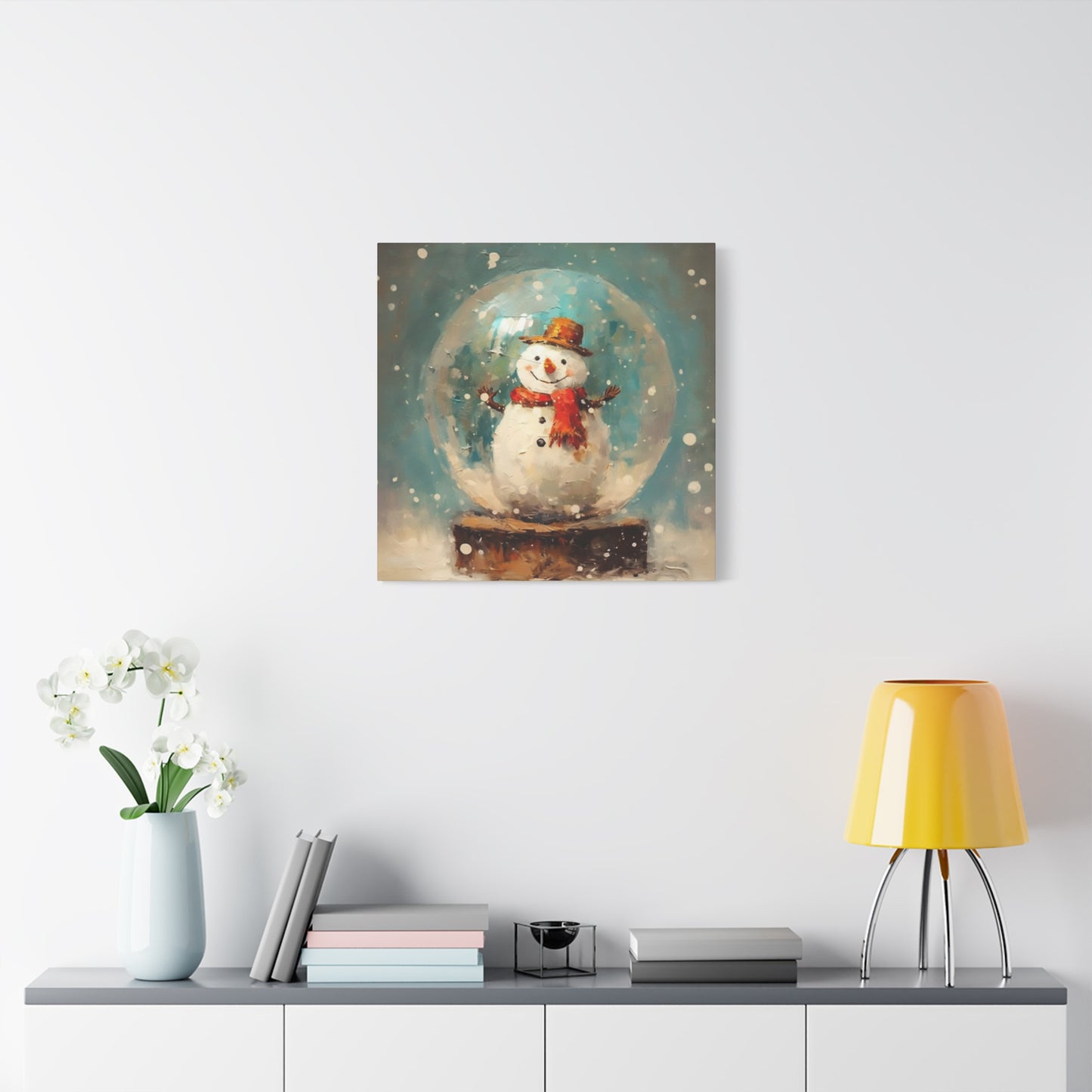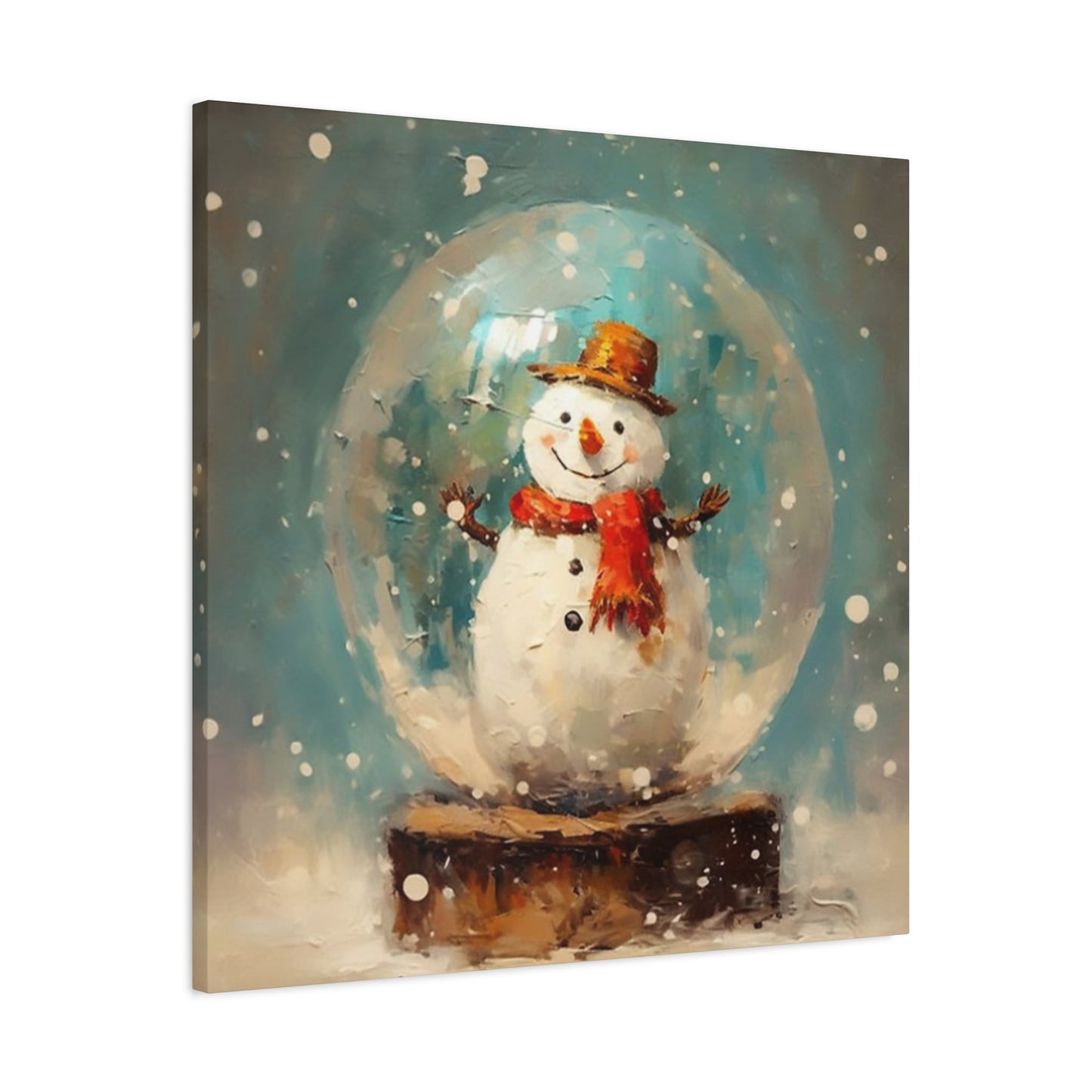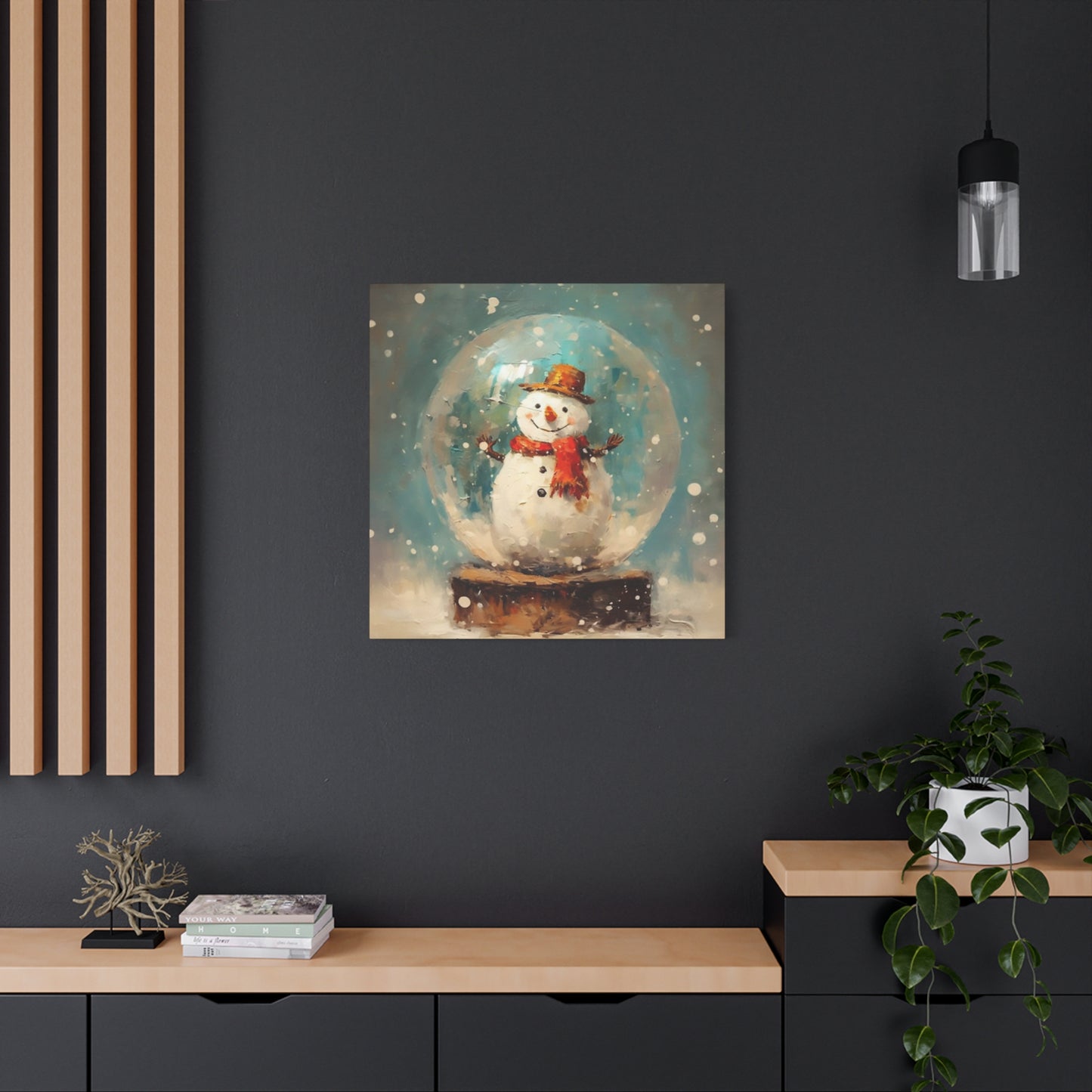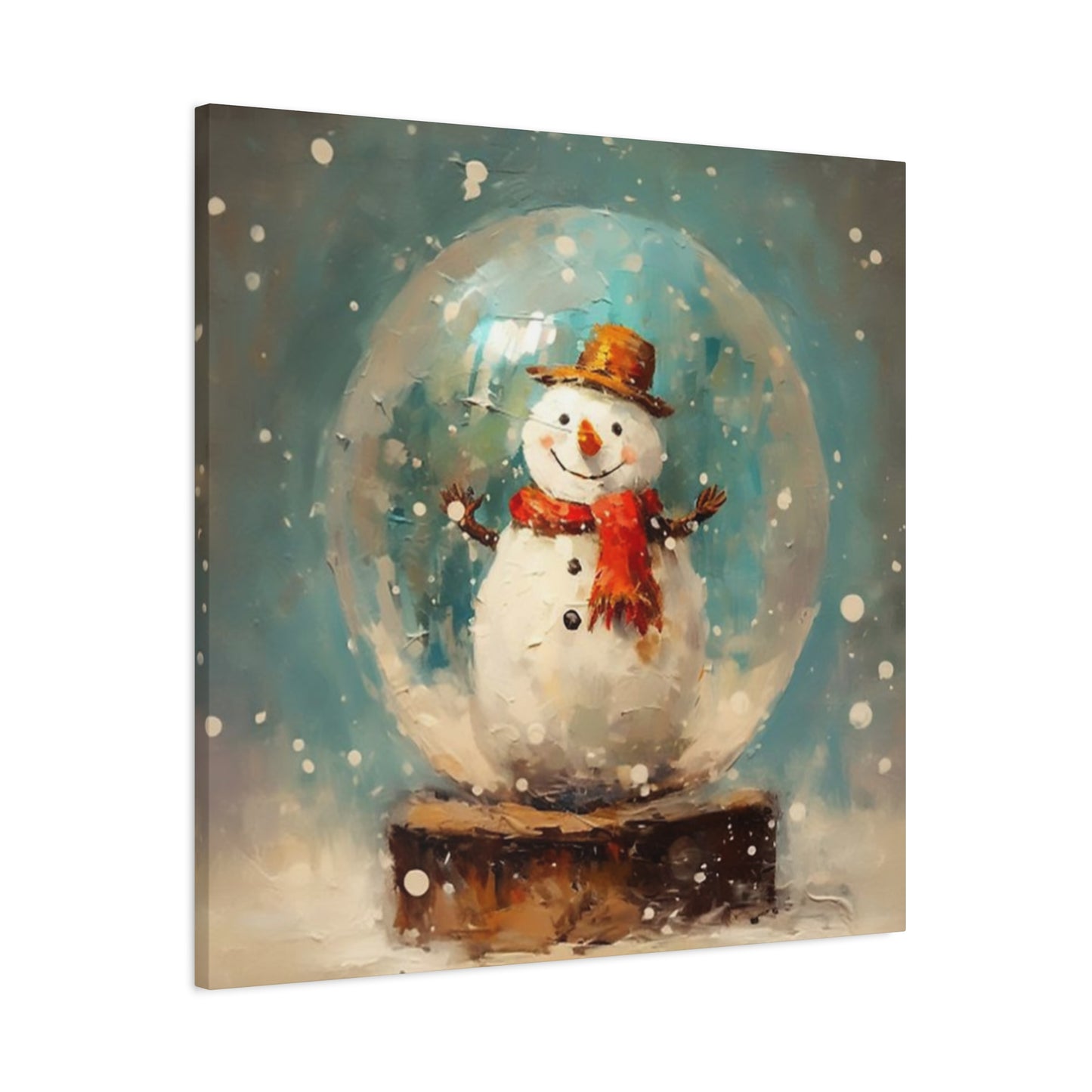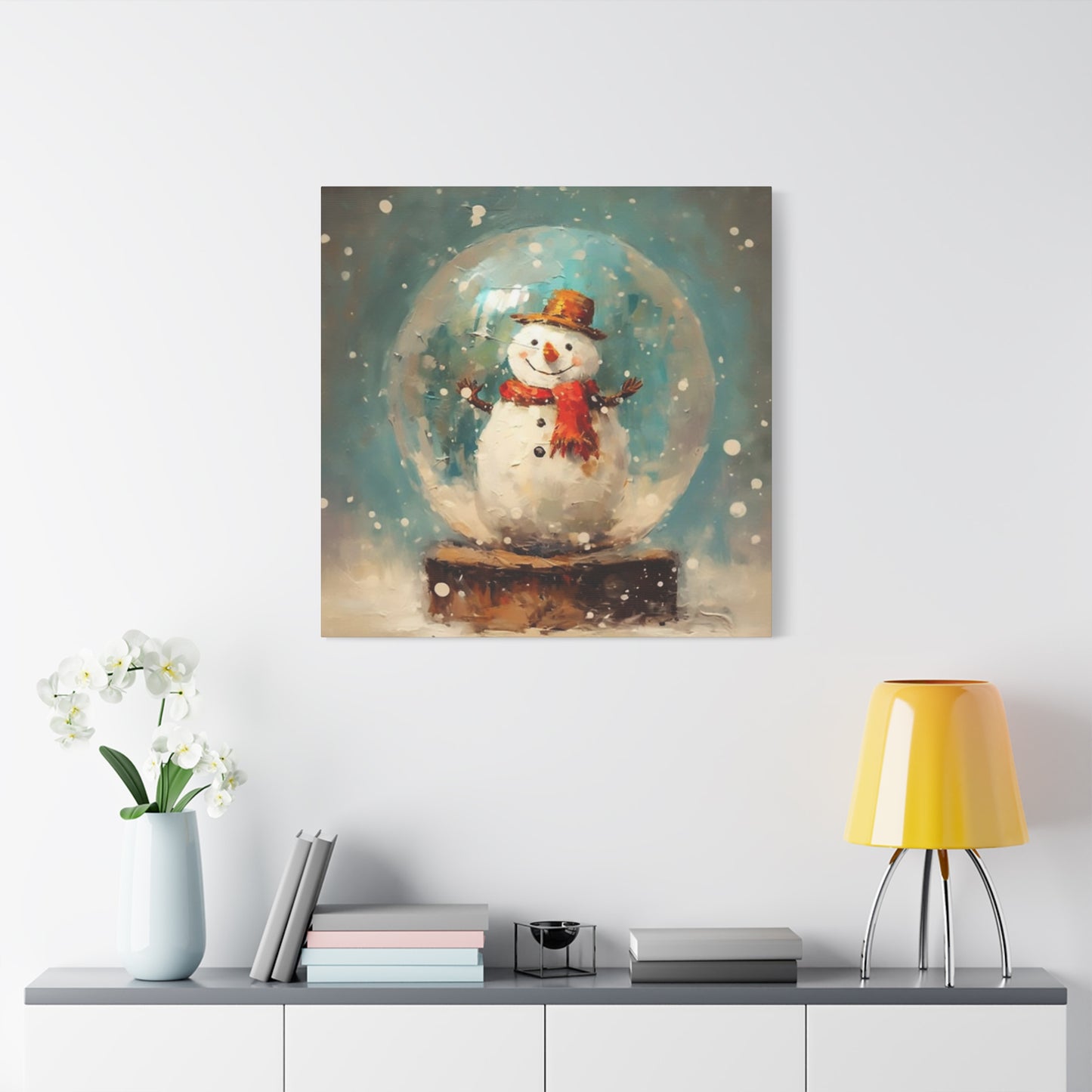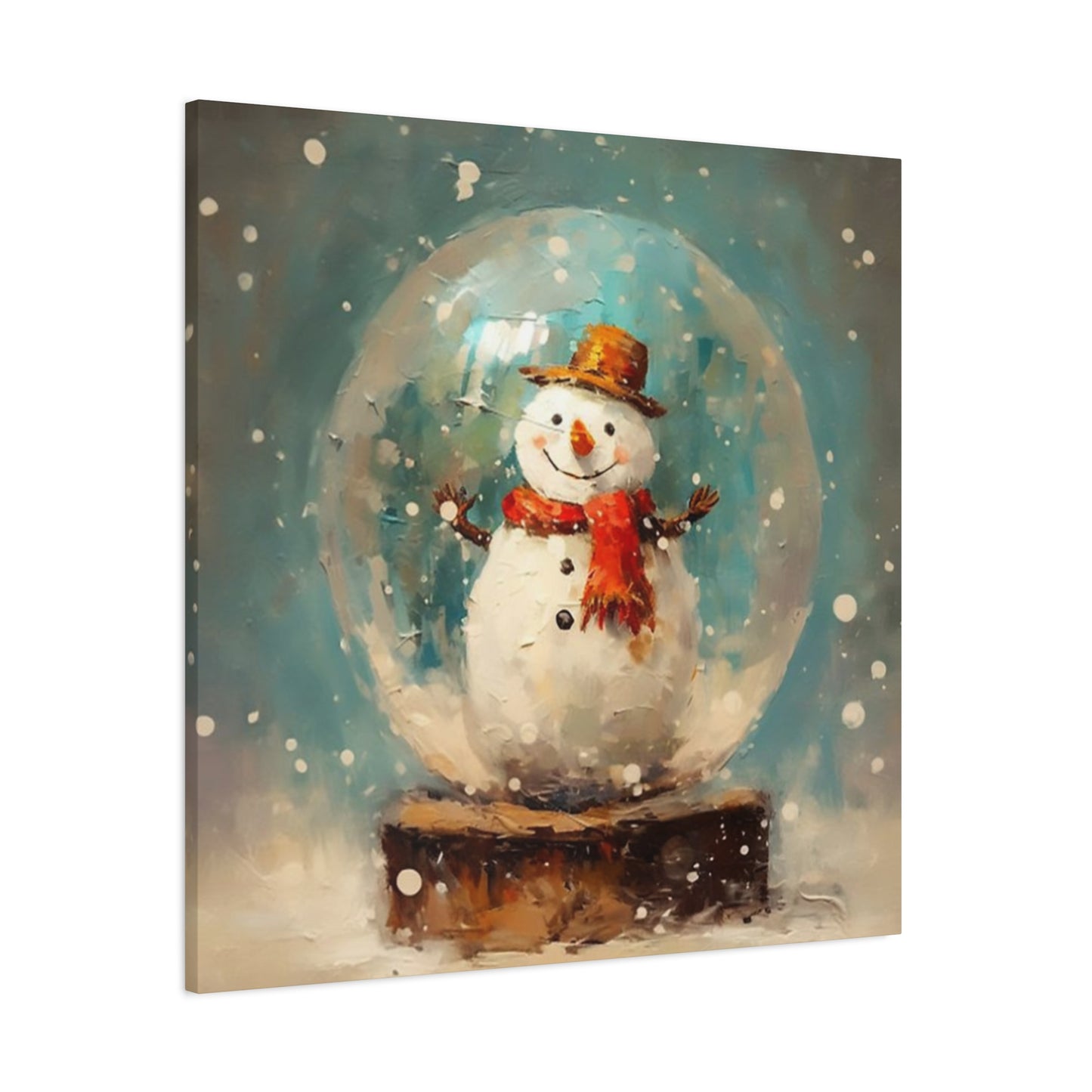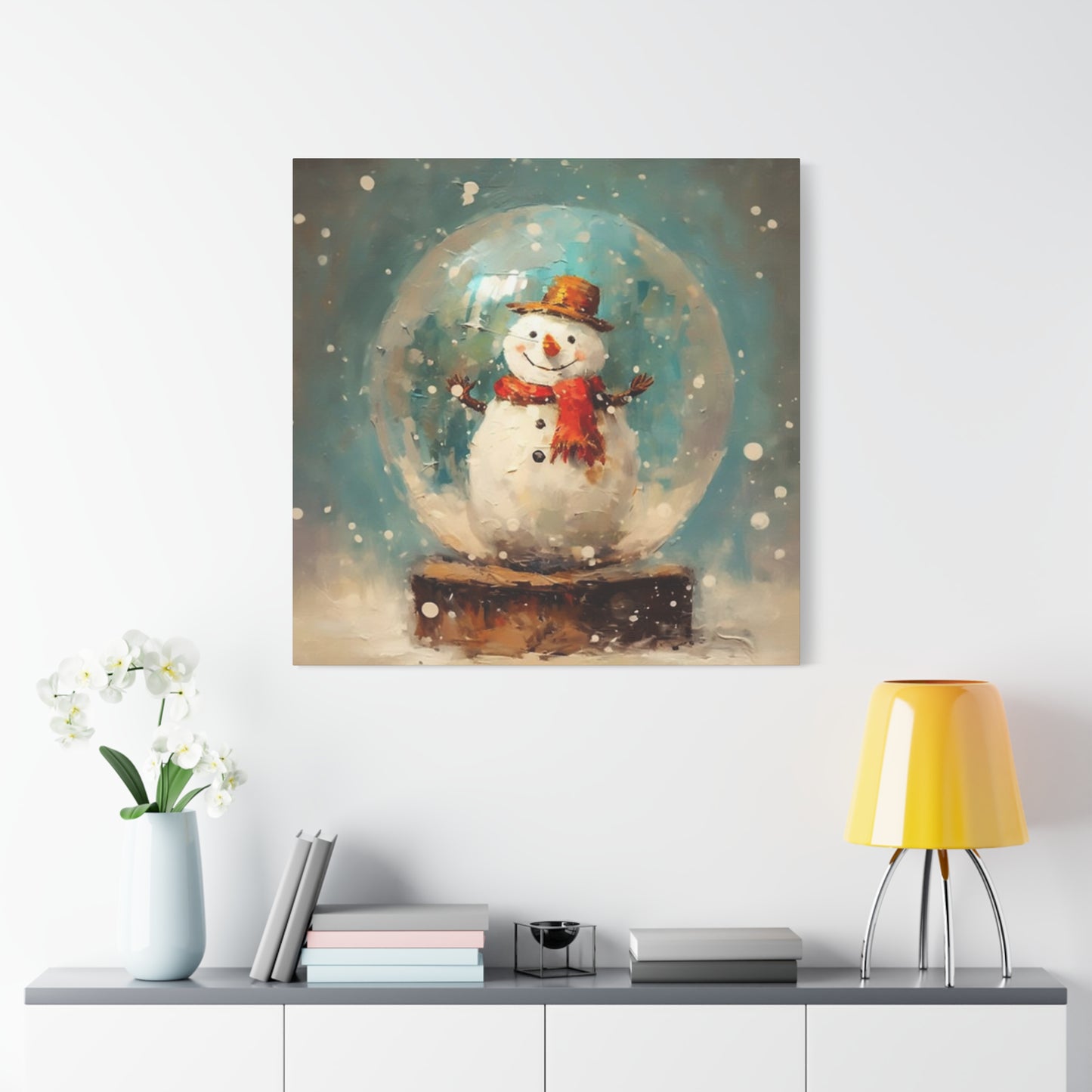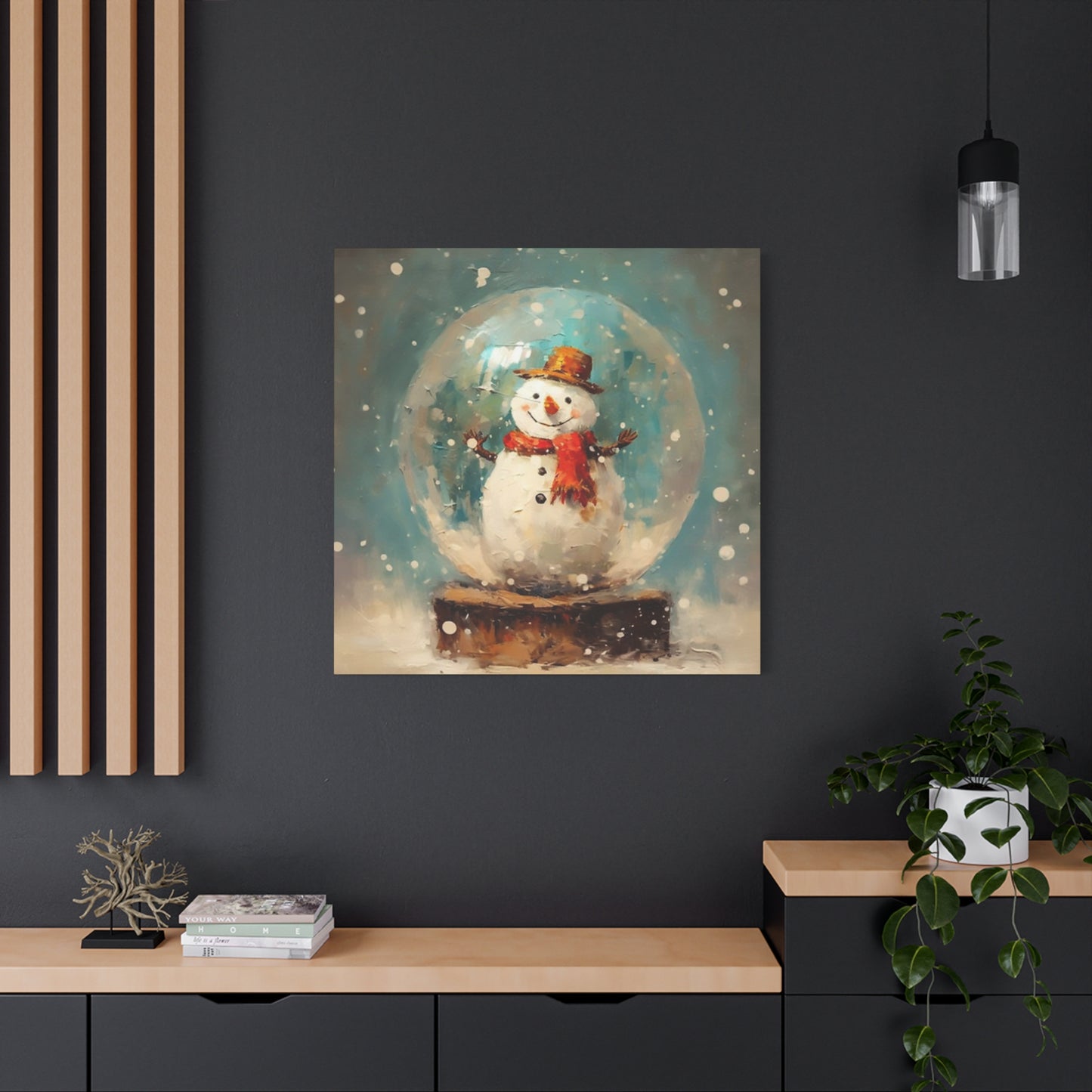Festive Elegance: Using Snowman Snow Globe Wall Art to Create Seasonal Ambiance
Winter brings with it a unique charm that transforms ordinary spaces into magical wonderlands. Among the most enchanting decorative elements that capture this seasonal beauty are artistic representations of snowmen encased within crystalline spheres, creating timeless pieces that celebrate the joy and wonder of the coldest months. These decorative creations have become increasingly popular among homeowners, interior designers, and holiday enthusiasts who seek to bring warmth and festivity into their living spaces throughout the winter season.
The appeal of these winter-themed decorative pieces extends far beyond simple seasonal decoration. They represent nostalgia, childhood memories, and the magical feeling that comes with the first snowfall of the year. Each piece tells a story of winter wonder, capturing moments of joy frozen in time within their spherical confines. Whether displayed in living rooms, bedrooms, hallways, or even commercial spaces, these artistic creations have the power to transform any environment into a cozy winter retreat.
This comprehensive exploration delves into the fascinating world of winter-themed canvas artwork featuring snowmen within glass spheres, examining every aspect from artistic styles and design elements to placement strategies and seasonal decorating tips. We will journey through various interpretations of this beloved theme, understanding how different artistic approaches can create unique atmospheric effects in your home. From vintage-inspired designs that evoke memories of Christmases past to contemporary interpretations that blend traditional themes with modern aesthetics, the variety available ensures that every taste and interior design style can find the perfect match.
The growing popularity of these decorative pieces reflects a broader trend in home décor toward creating spaces that evoke specific emotions and memories. Unlike generic artwork, winter-themed canvas prints featuring snowmen in glass spheres carry inherent storytelling elements that resonate with viewers on a personal level. They remind us of building snowmen with family, the excitement of snow days, and the peaceful quiet that blankets the world during a winter storm. This emotional connection makes them more than mere decorations; they become conversation starters, memory triggers, and cherished parts of our home environments.
Enchanting Winter Character Sphere Artistic Displays
The artistic representation of jolly winter figures enclosed within transparent spherical containers has evolved into a sophisticated form of seasonal home decoration. These pieces capture the essence of winter magic through careful attention to detail, color palette selection, and compositional balance. Artists who specialize in this genre understand the delicate interplay between the subject matter and the container that frames it, creating depth and dimension that draws viewers into miniature winter worlds.
When examining high-quality examples of this art form, several key elements become apparent. The winter character itself typically serves as the focal point, positioned prominently within the spherical space. The character's expression, posture, and accessories all contribute to the overall mood of the piece. Some artists opt for traditional representations with coal buttons and carrot noses, while others take creative liberties, adding scarves, hats, and other winter accessories that enhance personality and charm.
The sphere itself presents unique artistic challenges and opportunities. Creating the illusion of glass or crystal requires masterful use of highlights, shadows, and transparency effects. Skilled artists incorporate reflections and refractions that make the sphere appear three-dimensional on a two-dimensional canvas. The base of the sphere often features snow accumulation or decorative elements that anchor the composition and provide visual weight to the bottom of the piece.
Background elements within the sphere contribute significantly to the storytelling aspect of these artworks. Falling snowflakes, distant winter trees, twinkling stars, or northern lights all add layers of visual interest and depth. These elements must be carefully balanced to support rather than overwhelm the central character. The most successful compositions guide the viewer's eye naturally around the entire scene, creating a circular viewing pattern that mirrors the spherical container.
Color theory plays a crucial role in these artistic creations. Traditional winter palettes often feature cool blues, crisp whites, and silver tones that evoke the chill and clarity of winter air. However, artists frequently introduce warm accent colors through the character's accessories or background elements, creating visual contrast and emotional warmth. This juxtaposition of cool and warm tones prevents the artwork from feeling cold or uninviting, instead creating a cozy, welcoming atmosphere.
The texture representation in quality canvas prints adds another dimension to these pieces. From the smooth, reflective surface of the glass sphere to the fluffy texture of falling snow, from the rough weave of a winter scarf to the smooth curves of the character's form, textural variety creates visual interest and tactile appeal. Even though viewers cannot physically touch these textures, skilled artistic rendering makes them almost palpable.
Lighting effects within these compositions deserve special attention. Many artists incorporate internal light sources that make the sphere appear to glow from within. This technique not only adds visual drama but also enhances the magical quality of the piece. The interplay of light and shadow within the confined space of the sphere creates depth and dimension, making the artwork appear to have physical presence beyond the flatness of the canvas.
Celebratory Sphere Canvas Reproduction Collections
The market for seasonal canvas reproductions has expanded dramatically in recent years, with collections featuring winter characters in spherical settings becoming particularly sought after. These collections often present variations on a theme, allowing collectors to create cohesive displays or rotate pieces seasonally. Understanding the different styles and approaches within these collections helps buyers make informed decisions that align with their personal aesthetic preferences and existing home décor.
Traditional collection styles draw inspiration from vintage holiday imagery and nostalgic winter scenes. These pieces often feature muted color palettes reminiscent of antique postcards or early twentieth-century illustrations. The winter characters in these collections tend to have simpler, more classic designs that evoke a sense of timeless charm. Background elements typically include traditional winter imagery such as snow-covered evergreens, quaint cottages, or starlit skies. These collections appeal to individuals who appreciate classic holiday aesthetics and want to create a sense of continuity with past generations.
Contemporary collection approaches reimagine the traditional theme through modern artistic lenses. These might incorporate abstract elements, unconventional color schemes, or minimalist design principles. The spherical container might be rendered with clean lines and simple highlights rather than detailed realism. Background elements could be suggested rather than explicitly detailed, creating a more sophisticated, gallery-ready appearance. These collections work beautifully in modern interiors where traditional holiday décor might feel out of place.
Whimsical collection styles embrace playfulness and creativity, featuring winter characters with exaggerated features, fantastical settings, or unexpected color combinations. These pieces might show characters engaged in humorous activities, surrounded by imaginative elements that depart from strict realism. The spheres themselves might be decorated with unusual patterns or contain impossible elements that emphasize the magical nature of the scene. These collections appeal to families with children or anyone who appreciates lighthearted, joyful holiday décor.
Rustic collection aesthetics incorporate natural elements and earthy tones into the winter sphere theme. These pieces might feature wooden sphere bases, birch branch accents, or backgrounds that emphasize natural winter landscapes. The color palettes tend toward warm browns, deep greens, and natural whites rather than bright, artificial colors. The winter characters in these collections often appear more naturalistic, with textures that suggest actual snow, twigs, and natural materials. These collections complement farmhouse, cottage, or nature-inspired interior design styles.
Elegant collection variations elevate the winter sphere theme to sophisticated art pieces suitable for formal spaces. These might feature metallic accents, refined color palettes of silver, gold, and white, and compositional balance that emphasizes grace and beauty. The spheres themselves might be rendered with crystal-like clarity and brilliance, while background elements suggest luxury through careful detail and refined execution. These collections work well in dining rooms, formal living areas, or spaces where holiday décor needs to maintain a sense of elegance.
Series collections tell visual stories across multiple pieces, with each canvas representing a different scene or moment in a winter narrative. A collection might show the progression of a winter day from dawn to dusk, or different characters engaged in various winter activities. When displayed together, these pieces create a cohesive narrative that adds depth and interest to the viewing experience. Series collections work particularly well in hallways, stairways, or large wall spaces where multiple pieces can be displayed as a unified installation.
Limited edition collections offer exclusivity and collectibility for serious enthusiasts. These pieces might feature signature elements from specific artists, unique size options, or special finishing techniques not available in standard reproductions. The limited nature of these collections adds value and creates opportunities for collection building over multiple seasons. Serious collectors often seek out these exclusive offerings to create distinctive displays that cannot be easily replicated.
Winter Character Within Sphere Seasonal Interior Decoration
Integrating seasonal artwork featuring winter characters in spherical settings requires thoughtful consideration of placement, lighting, and surrounding décor elements. These pieces have the potential to transform spaces, but their impact depends significantly on how they are incorporated into the overall design scheme. Understanding the principles of effective seasonal decorating ensures that these artworks enhance rather than overwhelm your living spaces.
The entry or foyer represents an ideal location for welcoming seasonal artwork. This space sets the tone for the entire home, and a striking piece featuring a winter character in a sphere immediately establishes the seasonal theme. In this location, consider larger format pieces that make a bold statement. The artwork should be positioned at eye level for average height individuals, typically with the center of the piece approximately sixty inches from the floor. If your entry includes a console table or bench, the artwork can be hung above it, creating a cohesive vignette when combined with seasonal accessories like pinecones, candles, or small decorative spheres that echo the artwork's theme.
Living room placement offers numerous possibilities depending on the room's layout and existing furnishings. Above a fireplace mantel represents a traditional and effective location, where the artwork becomes a focal point during gatherings. The horizontal expanse above a sofa provides another excellent opportunity, either for a single large piece or a collection of smaller coordinating works. When placing artwork above furniture, maintain a gap of approximately six to eight inches between the furniture top and the bottom edge of the frame. This creates visual connection without making the artwork appear to sit directly on the furniture.
Dining areas benefit from seasonal artwork that enhances the festive atmosphere of holiday meals and gatherings. In dining rooms, consider the viewing angles from seated positions around the table. Artwork should be positioned to be appreciated from these seated perspectives. A collection of smaller pieces arranged in a grid or linear pattern can create an impressive display without overwhelming the space. The color palette of the artwork should complement or thoughtfully contrast with the dining room's existing color scheme and table settings.
Bedroom placement of winter sphere artwork creates a personal retreat that celebrates the season. Above the headboard represents the most common placement, but consider alternative locations such as opposite the bed where the artwork becomes the first thing you see upon waking. In bedrooms, artwork with calmer compositions and softer color palettes promotes relaxation and restfulness. Avoid overly bright or busy designs that might prove visually stimulating when you're trying to unwind.
Hallways and stairways offer often underutilized spaces perfect for displaying collections of seasonal artwork. These transitional spaces benefit from visual interest that rewards movement through the home. In hallways, consider creating a gallery wall of various sizes, all featuring the winter sphere theme but with different compositions or color emphases. Along stairways, arrange pieces in ascending or descending patterns that complement the architectural lines. Ensure consistent spacing between pieces for a cohesive, intentional appearance.
Kitchen and breakfast nook placements bring seasonal cheer to spaces where families gather daily. These areas typically accommodate smaller pieces due to cabinet and window placement constraints. Look for wall spaces near eating areas or above coffee stations. In kitchens, ensure artwork is positioned away from direct exposure to cooking heat and moisture, which can damage canvas prints over time. The casual nature of these spaces allows for more playful, whimsical interpretations of the winter sphere theme.
Home office seasonal decoration helps maintain festive spirit even during work hours. A single carefully chosen piece positioned within the line of sight from your desk can provide welcome visual breaks and mood enhancement. In home offices, consider how the artwork appears during video calls if your camera captures the wall behind you. Artwork that's visually interesting but not distracting works best in these situations. The winter sphere theme can add personality to professional spaces without appearing overly casual.
Children's rooms and play areas particularly benefit from winter sphere artwork featuring more whimsical or colorful interpretations. These spaces allow for bolder color choices and more imaginative compositions. Position artwork at heights appropriate for children's viewing, which might be lower than standard adult eye level. Consider creating a dedicated seasonal display area where artwork can be easily rotated as interests change or as children grow.
Mystical Sphere Holiday Season Artistic Creations
The intersection of mysticism and winter celebration creates particularly captivating artistic interpretations within the sphere format. These pieces transcend simple seasonal decoration, incorporating elements of wonder, magic, and enchantment that elevate them to contemplative art. Understanding the symbolic and aesthetic elements that create this mystical quality helps appreciate why these particular works resonate so deeply with viewers.
Celestial elements frequently appear in mystical interpretations, with stars, moons, and cosmic dust swirling within and around the spherical container. These astronomical references connect the earthbound winter character to the vast universe, suggesting wonder at forces larger than ourselves. Artists might depict constellations specific to winter skies, the Milky Way arching across the background, or abstract stellar patterns that suggest infinite space. The winter character, positioned within this cosmic context, becomes a contemplative figure rather than merely a cheerful decoration.
Ethereal lighting effects distinguish mystical pieces from more straightforward seasonal artwork. Rather than natural lighting that mimics sunshine or lamplight, these pieces often feature inexplicable glows, aurora-like shimmer effects, or light that seems to emanate from the character itself. This supernatural illumination creates atmosphere and suggests presence of magic or spiritual forces. The light might cast unusual shadows, create rainbow prismatic effects through the sphere's glass, or illuminate falling snow in ways that defy normal physics.
Symbolic elements woven throughout mystical compositions add layers of meaning for contemplative viewers. Evergreen branches represent eternal life and continuity through harsh seasons. Specific numbers of stars or snowflakes might reference numerological significance. Birds, particularly cardinals or doves, symbolize messages from loved ones or spiritual presence. These symbolic elements allow the artwork to function on multiple levels, appearing as simple seasonal decoration to casual observers while offering deeper significance to those who look more carefully.
Color palettes in mystical interpretations often venture beyond traditional winter tones. Deep purples suggesting twilight magic, rich teals evoking frozen mystical waters, or unexpected gold and copper tones referencing alchemy and transformation all create distinctive atmospheric effects. These unconventional colors distinguish mystical pieces from standard holiday décor while maintaining winter season appropriateness. The sophisticated color choices allow these pieces to remain displayed well beyond traditional holiday periods without appearing seasonally out of place.
Mythological and folkloric references occasionally appear in mystical winter sphere artwork. The winter character might be portrayed in the style of folk art traditions from various cultures, incorporating symbolic patterns or design elements from specific regions. References to winter solstice celebrations, ancient winter festivals, or folklore surrounding the darkest days of the year add cultural depth. These references connect contemporary viewers to ancient human experiences of winter and the celebrations that helped communities endure the season.
Meditation and mindfulness themes emerge in particularly contemplative mystical pieces. The contained world within the sphere can represent the inner self, protected and preserved within its transparent container. The gentle fall of snow becomes analogous to thoughts settling, while the serene expression of the character suggests peaceful acceptance of winter's stillness. These pieces function as visual focal points for meditation or mindfulness practice, with the repetitive elements and balanced compositions providing anchor points for attention.
Dream-like qualities characterize many mystical interpretations, with compositions that embrace surrealism or impossible perspectives. The sphere might contain spaces larger than its exterior dimensions suggest, with vast winter landscapes visible within impossibly small confines. Multiple spheres might be nested within one another, each containing different scenes or seasonal moments. Time might appear fluid, with a single composition showing dawn, noon, and twilight simultaneously. These dream-like elements remind viewers that art need not conform to physical reality to convey emotional truth.
Spiritual and religious symbolism occasionally appears in mystical winter sphere artwork, though typically in subtle rather than overt ways. The sphere itself references halos, divine presence, and protection. The winter character might be positioned in poses suggesting blessing or benediction. Background elements might include churches, stars positioned in meaningful configurations, or light effects that suggest heavenly origins. These pieces allow viewers to connect seasonal celebration with personal spiritual practices and beliefs.
Winter Character Holiday Circular Container Canvas
The specific artistic challenge of representing three-dimensional spherical containers on two-dimensional canvas surfaces has inspired impressive technical innovations and creative solutions. Understanding how artists approach this challenge provides appreciation for the skill involved in creating convincing sphere representations that appear to have actual depth and physical presence beyond the flat canvas surface.
Perspective representation forms the foundation of convincing sphere depiction. Artists must understand how three-dimensional spherical forms appear to the human eye, including how curves appear to compress and how internal elements appear to recede into space. The circular opening at the sphere's front must be rendered as a perfect or near-perfect circle when viewed straight on, while any tilt or angle to the sphere requires sophisticated understanding of elliptical perspective. The base of the sphere, where it meets a surface or stand, requires careful attention to contact shadows and reflective surfaces.
Transparency techniques separate amateur from professional sphere representations. Creating the illusion of looking through clear glass or crystal requires masterful handling of multiple visual elements simultaneously. The artist must show what lies behind the sphere, distorted appropriately by the curved glass surface. The sphere's edges must feature realistic thickness, with light bending as it passes through glass. Internal elements must appear both clear and slightly softened by the medium through which we view them. Highlights positioned correctly across the sphere's surface suggest light sources and convey the smooth, hard quality of glass.
Refraction effects add realism and visual interest to sphere representations. Light bends as it passes through curved glass surfaces, creating subtle distortions and color separation effects similar to prisms. Skilled artists incorporate these effects subtly, avoiding exaggeration that would appear cartoonish while including enough refraction to convince the eye that it's viewing an actual glass object. The refraction might create slight rainbow effects along certain edges or cause background elements to appear shifted from their actual positions.
Internal atmosphere within the sphere contributes significantly to the sense of enclosed space. Artists create the impression of air or snow-filled space inside the container through careful manipulation of values and edges. Elements closer to the viewer appear sharper and more detailed, while those deeper in the sphere become progressively softer and lighter. Falling snow might be sharply detailed in the foreground but become mere suggestions of white dots in the background. This atmospheric perspective within the confined space of the sphere creates convincing depth.
Surface reflections on the sphere's exterior require careful observation and rendering. The sphere reflects elements from its surrounding environment, whether that's the room it sits in or an imagined setting. These reflections must follow the curved surface of the sphere, appearing distorted and wrapped around the spherical form. Reflections are typically more prominent on the shadowed side of the sphere, where they provide visual information about the surrounding environment and help define the sphere's volume.
Shadow casting from both the sphere itself and the elements within it adds dimensional reality. The sphere casts a shadow on the surface beneath it, with the shadow's shape, softness, and darkness depending on the light source characteristics. Inside the sphere, the winter character and other elements cast their own shadows on the sphere's interior back surface. These internal shadows must account for light filtering through the glass container, typically appearing softer and more diffused than shadows cast in open air.
Material quality representation distinguishes different types of spherical containers. A snow globe made of cheap pressed glass appears different from one crafted from lead crystal. Artists convey these material differences through the quantity, quality, and placement of highlights, the degree of clarity or slight cloudiness in the glass, and the weight and substance suggested by the rendering. Vintage or antique spheres might show slight imperfections, bubbles, or distortions that add character and authenticity to the representation.
Base and stand details anchor the sphere in physical reality. Whether the sphere sits on an ornate brass base, a simple wooden platform, or a contemporary clear pedestal, this foundation requires as much careful rendering as the sphere itself. The junction between sphere and base shows contact shadows, possible reflections between materials, and the weight of the sphere resting on its support. Decorative elements on the base, such as engravings, patterns, or plaques, add visual interest and provide opportunities for artistic embellishment.
Glistening Sphere Scene Interior Wall Artistic Display
The interplay of light effects within winter sphere artwork creates the impression of illumination and sparkle that makes these pieces particularly captivating. Understanding how artists achieve these luminous effects helps viewers appreciate the technical skill involved and guides collectors in selecting pieces that will create desired atmospheric effects in their homes.
Internal illumination effects make spheres appear to glow from within, as if lit by contained magic or electrical elements. Artists achieve this effect through careful gradation of values, starting with lighter tones at the center or around the light source and gradually darkening toward the sphere's edges. The light must interact realistically with internal elements, casting soft glows on the winter character and creating subtle shadows. The glass or crystal sphere itself acts as a lens, potentially focusing or diffusing the internal light in ways that add visual complexity.
Sparkle and glitter effects simulate the diamond-like quality of ice crystals, falling snow, or decorative elements within the sphere. Artists represent individual points of light reflection through small, bright highlights positioned strategically throughout the composition. These sparkles follow predictable patterns based on the light source direction but are scattered enough to suggest the random nature of reflective snow crystals. The intensity and number of sparkle points must be carefully balanced; too few and the winter scene lacks the magical quality desired, too many and the composition becomes visually chaotic.
Snow luminescence captures the unique way snow reflects and diffuses light. Fresh snow has exceptional reflective properties, bouncing light in multiple directions and creating overall illumination even in relatively dim conditions. Artists represent this quality through careful control of values throughout snowy areas. Rather than painting snow as pure white, skilled artists use subtle blues, lavenders, and warm tones that suggest reflected light from sky and surrounding surfaces. This approach creates snow that appears luminous rather than flat.
Star and celestial light effects add magical qualities to sphere compositions. Whether depicting realistic stars visible through a clear winter sky or more fantastical stellar elements, the treatment of these light sources significantly impacts the overall mood. Stars might be rendered as simple points of light, as radiating star shapes with multiple points, or as soft glowing orbs with surrounding halos. Particularly bright stars or planetary bodies might create visible light rays or atmospheric glows that extend throughout the composition.
Moonlight effects create specific atmospheric qualities that differ from sunlight or artificial illumination. Moonlight appears cooler in tone, with artists typically using blues, blue-violets, and cool whites to represent lunar illumination. Moonlight in winter scenes creates strong value contrasts between illuminated and shadowed areas while maintaining an overall sense of nighttime darkness. The moon itself, whether fully visible in the background or implied through the quality of light, might be rendered with surface detail or as a simplified glowing orb depending on the piece's overall style and level of realism.
Candlelight and firelight effects introduce warm, flickering illumination that contrasts beautifully with cool winter tones. These organic light sources create yellows, oranges, and warm reds that provide emotional warmth even while depicting cold winter scenes. The light from these sources is typically more localized than moonlight or sunlight, creating dramatic light falloff and deep shadows. Flickering fire or candlelight can be suggested through slight variations in light intensity and warm color variations throughout the illuminated areas.
Aurora effects bring dramatic colored light phenomena into winter sphere compositions. The northern lights' characteristic bands of green, purple, pink, and yellow create striking backdrops for winter characters. Artists must balance the dramatic quality of auroral light with the composition's overall readability, ensuring the winter character remains the focal point despite the spectacular background. Aurora effects work particularly well in pieces meant to evoke wonder and magic, connecting earthbound winter activities with cosmic atmospheric phenomena.
Reflected light creates subtle illumination in shadowed areas and adds dimensional complexity. Light bouncing off snow, the interior of the glass sphere, or reflective surfaces within the composition provides secondary illumination that softens shadows and creates color interest in areas not directly lit. Artists suggest this reflected light through warm or cool color notes in shadow areas and by ensuring shadows remain transparent rather than appearing as flat black shapes. This attention to reflected light creates atmospheric unity throughout the composition.
Winter Character and Frozen Crystals Canvas Reproductions
The combination of winter characters with detailed snowflake representations creates opportunities for stunning visual displays that celebrate both whimsy and natural geometry. Snowflakes' infinite variety and intricate structure provide artistic elements that complement the softer, rounder forms of winter characters while adding textural and visual interest throughout the composition.
Snowflake scientific accuracy varies significantly between artistic interpretations. Some artists research actual snowflake structures, depicting the hexagonal symmetry and elaborate dendritic branching patterns that form under specific atmospheric conditions. These scientifically informed representations appeal to viewers who appreciate nature's mathematical precision. Individual snowflakes might be rendered with incredible detail, showing the primary arms radiating from the central hexagonal core, secondary branching, and the decorative elaborations that make each crystal unique.
Stylized snowflake designs depart from strict realism to create decorative elements that serve the composition's overall aesthetic goals. These might feature simplified geometric patterns, exaggerated symmetry, or artistic embellishments that enhance visual appeal while maintaining the recognizable snowflake form. Stylized snowflakes often incorporate color variations, metallic effects, or decorative centers that would never appear in natural ice crystals but create desired visual effects within the artwork.
Snowflake size variation throughout the composition creates depth and atmospheric perspective. Larger, more detailed snowflakes appear to float in the immediate foreground, close to the sphere's glass surface or to the viewer. Medium-sized snowflakes populate the middle ground, while smaller, simpler snowflakes recede into the background and distance. This graduated sizing guides the viewer's eye through the composition and creates the impression of snow actively falling through three-dimensional space rather than existing as a flat pattern.
Snowflake positioning and density requires careful compositional consideration. Too many snowflakes overwhelm the composition and obscure the winter character and other important elements. Too few fail to create the atmospheric winter conditions desired. Strategic positioning ensures snowflakes enhance rather than compete with the focal point. Artists often increase snowflake density in certain areas while leaving other regions relatively clear, creating visual rhythm and preventing monotonous, uniform distribution.
Snowflake motion representation adds dynamic energy to otherwise static compositions. Individual snowflakes might appear slightly elongated or have small motion blur effects suggesting their fall through air. Snowflakes might accumulate more densely near the sphere's bottom, suggesting settling. Curves or swirls in snowflake placement imply wind currents moving through the scene. These motion suggestions transform falling snow from mere decorative elements into active participants in the winter story being told.
Crystalline structure details separate masterful snowflake rendering from simple white dots or asterisks. Even in smaller snowflakes, careful artists suggest the internal structure through subtle value changes that indicate thickness variations in the crystal arms. The way light passes through ice creates specific visual qualities, with thicker areas appearing slightly darker or bluer while thinner areas might appear almost transparent. These subtle optical effects, when faithfully rendered, create snowflakes that appear as actual ice crystals rather than painted decorations.
Color variations in snowflake rendering prevent visual monotony and create atmospheric effects. While snowflakes themselves are colorless ice crystals, they appear to take on color through reflected and transmitted light. Snowflakes near warm light sources might appear cream or pale gold, while those in shadowed or moonlit areas might show blues, lavenders, or subtle greens. These color variations create unity between the snowflakes and the overall composition's color scheme while maintaining the essential whiteness associated with snow.
Interactive relationships between snowflakes and other compositional elements add narrative interest. Snowflakes might land on the winter character's hat or arms, accumulate on evergreen branches, or collect at the sphere's base. Some snowflakes might appear caught mid-collision with the sphere's interior surface, creating small distortions or water droplets. These interactions suggest the dynamic relationships between elements within the enclosed winter world and add layers of observational detail that reward close viewing.
Comfortable Winter Sphere Seasonal Interior Design Elements
Creating comfortable, inviting seasonal displays requires balancing visual impact with livability and warmth. Winter sphere artwork contributes to cozy environments when incorporated thoughtfully into broader design schemes that emphasize comfort, warmth, and seasonal celebration without sacrificing everyday functionality or comfort.
Textile coordination with winter sphere artwork creates cohesive design schemes. Throw pillows, blankets, and window treatments in colors that echo the artwork's palette unify the space. Consider incorporating textures that reference winter elements depicted in the artwork - faux fur suggesting snow, chunky knits evoking hand-knit scarves, or smooth velvet reflecting moonlight on fresh snow. These textile choices don't need to be literal or obvious; subtle connections through color, texture, or pattern create sophisticated coordination.
Layered lighting approaches ensure artwork remains visible and impactful throughout varying times of day and lighting conditions. Dedicated picture lights positioned above artwork create focused illumination that makes the piece glow even in dim room lighting. Table and floor lamps positioned to cast indirect light toward artwork add gentle illumination without creating glare. Dimmer switches allow lighting adjustment to create different moods, from bright and energetic for gatherings to soft and contemplative for quiet evenings.
Furniture arrangement that considers artwork placement ensures pieces remain visible and appreciated. Seating should be positioned to allow comfortable viewing of displayed artwork without requiring awkward neck positions. Coffee tables, side tables, and other surfaces shouldn't obstruct sightlines to wall art. In rooms with multiple seating areas, consider which pieces of artwork are visible from each position and whether the viewing experience from all seats feels balanced and intentional.
Accessory coordination extends the winter sphere theme throughout the space without overwhelming it. A few carefully chosen objects that echo the artwork's theme, colors, or shapes create thematic unity. This might include small decorative spheres on shelves, winter character figurines, crystal objects that reference the glass sphere, or natural elements like pinecones and branches. The key lies in restraint; several thoughtfully chosen accessories prove more effective than numerous themed items that create visual clutter.
Scent integration adds sensory dimension to winter-themed spaces. Candles, diffusers, or subtle room sprays in winter-appropriate scents complement visual winter themes. Pine, peppermint, cinnamon, and vanilla create olfactory associations with winter and holiday seasons. These scents shouldn't be overpowering but rather provide subtle background fragrance that enhances the cozy atmosphere without triggering sensitivities or overwhelming the space.
Temperature and humidity considerations protect artwork while maintaining comfort. Canvas prints are sensitive to extreme temperature fluctuations and high humidity, which can cause warping, mold, or degradation of the printed image. Maintaining consistent comfortable indoor temperatures protects both artwork and inhabitants. Humidifiers used during dry winter months should be positioned to avoid directing moisture toward artwork, while maintaining moderate humidity levels prevents excessive dryness that damages both art and respiratory comfort.
Seasonal transition planning ensures spaces remain functional and attractive as winter gives way to spring. Consider how winter sphere artwork will be stored during off-season months. Climate-controlled storage protects investment pieces from temperature extremes and humidity. When ready to display artwork again, inspect for any damage that may have occurred during storage and address issues before hanging. Some collectors maintain dedicated seasonal display areas that make rotation easier and protect walls from excessive nail holes.
Multi-functional space considerations acknowledge that rooms serve multiple purposes. Living rooms function as entertainment spaces, relaxation areas, and sometimes work-from-home offices. Artwork selection and placement should enhance all these functions without interfering with any. Winter sphere artwork provides visual interest during video calls, creates conversation topics during gatherings, and offers pleasant views during relaxation without being so bold or busy that it becomes distracting during focused work.
Playful Winter Character Sphere Artistic Rendering
Whimsical interpretations of the winter character sphere theme embrace humor, imagination, and creative freedom, resulting in pieces that celebrate joy and playfulness. These lighthearted approaches appeal to families with children, individuals who appreciate humor in art, and anyone seeking to create cheerful, uplifting seasonal environments.
Character expression and personality shine through in whimsical pieces, with winter figures displaying exaggerated smiles, surprised expressions, or comically serious faces. The character might have oversized features, unusual proportions, or accessories that suggest personality and backstory. A winter character wearing swimming goggles and snorkel might suggest comedic confusion about seasonal appropriateness. Another might sport superhero cape, humorously elevating the humble winter figure to heroic status. These personality-filled characters become endearing figures rather than generic seasonal decorations.
Unexpected activities and scenarios create narrative interest and humor. A winter character might be depicted reading a book, talking on a telephone, riding a bicycle, or engaging in activities typically associated with other seasons or contexts. These unexpected juxtapositions create cognitive surprise that results in viewer delight. The humor doesn't rely on mockery but rather celebrates the absurd and unexpected, creating lighthearted entertainment appropriate for all ages.
Impossible physics and magical elements emphasize the fantastical nature of whimsical pieces. Snowflakes might flow upward rather than falling, defying gravity in impossible ways. The winter character might float within the sphere rather than standing on snow. Elements might appear to move in stop-motion sequences frozen mid-gesture. These reality-defying elements remind viewers that art exists in imaginative realms where normal rules need not apply, encouraging creative thinking and playful viewing.
Color choices in whimsical pieces often venture beyond naturalistic palettes into candy-bright hues and unexpected combinations. Hot pink snow, lime green spheres, or purple skies create eye-catching contrast with traditional winter imagery. These bold color choices appeal particularly to children and create energetic, exuberant moods. The colors might reference candy, toys, or other childhood associations, creating visual connections to joy and play.
Animal companions frequently appear in whimsical winter sphere artwork, adding additional characters and interaction opportunities. Penguins wearing bow ties, rabbits in sweaters, or birds with tiny hats create additional focal points and narrative possibilities. These animal friends might be helping build the winter character, having conversations, or engaged in their own humorous activities. The interaction between human-like winter figures and anthropomorphized animals adds layers of storytelling and appeal.
Scale distortions and size relationships create visual humor and interest. A tiny winter character might occupy an enormous sphere, lost in vast snowy space. Conversely, an oversized character might appear cramped in an inadequate container, perhaps with carrot nose pressed against the glass. Accessories might be scaled inappropriately, with a winter figure wearing a hat large enough to double as an umbrella. These scale manipulations create visual comedy and memorable images.
Patterned and decorated elements transform functional components into decorative focal points. The sphere base might feature bold patterns, the sphere itself could be decorated with stripes or dots, or the winter character might wear clothing covered in complex patterns. Backgrounds might incorporate geometric shapes, repeating patterns, or abstract designs rather than representational winter landscapes. These decorative approaches create busy, energetic compositions full of visual discovery.
Interactive elements within whimsical compositions suggest motion, sound, or other sensory experiences beyond the static image. Musical notes floating through the air suggest the character is singing. Motion lines indicate movement or dance. Speech or thought bubbles, while more common in comics than fine art, might occasionally appear to share the character's thoughts or comments. These elements, used judiciously, add narrative dimension without making the piece appear juvenile or cartoonish unless that aesthetic is specifically desired.
Conclusion:
The Snowman Snow Globe Wall Art collection embodies the enchanting spirit of the holiday season, transforming spaces into realms of festive warmth, wonder, and joy. These artworks capture the timeless charm of winter celebrations through the whimsical lens of snow globes, where the presence of snowmen evokes nostalgia, playfulness, and the magic of shared moments. Beyond mere decoration, this art form serves as an emotional conduit, inviting viewers to reconnect with the cozy, heartwarming sensations that define the holidays. Each canvas not only celebrates the beauty of winter but also creates an atmosphere that elevates seasonal décor into a captivating, immersive experience.
At the core of this collection is the ability of snow globe imagery to encapsulate miniature worlds of wonder. Within these delicate, self-contained landscapes, snowmen stand as symbols of joy, creativity, and tradition, their cheerful presence balancing the stillness of winter with the excitement of festivity. Kimble Warren’s attention to detail—whether in the gentle swirl of snow, the glimmer of reflective surfaces, or the subtle expressions of the snowmen—transforms simple winter motifs into dynamic stories. Viewers are invited to linger, to explore the layers of color, texture, and emotion that define each piece. This focus on narrative creates not only visual appeal but also a sense of participation, as though one could step into the snow globe world itself.
From an interior design perspective, snow globe wall art is remarkably versatile. Its color palette—often dominated by crisp whites, icy blues, and warm festive accents—blends effortlessly with traditional holiday décor as well as modern minimalist spaces. In living rooms, such pieces establish an instant focal point, infusing energy and charm into seasonal gatherings. In kitchens, entryways, or dining areas, they enhance ambiance, encouraging feelings of cheer, warmth, and togetherness. By incorporating snow globe imagery, homeowners can cultivate a cohesive seasonal aesthetic that elevates both mood and style, seamlessly merging festive elegance with visual sophistication.
Lighting is critical to amplifying the magic of snow globe art. Ambient light enhances the sparkling quality of falling snow and reflections within the globe, while strategically placed accent lighting highlights key details, such as the snowman’s expressive features or the intricate textures of miniature landscapes. The dynamic interplay between light and shadow mirrors the natural glow of winter mornings and festive evenings, creating a sense of movement and life that draws viewers into the scene. This attention to illumination ensures that the artwork remains engaging and enchanting throughout the day, enhancing the immersive quality that defines its appeal.
Emotionally, the snow globe wall art resonates deeply by evoking memories and connections tied to the holiday season. Snowmen, universally recognized as icons of winter joy, remind viewers of childhood excitement, family traditions, and the comfort of familiar celebrations. The snow globe, with its self-contained world, suggests both introspection and shared experience, encouraging reflection on cherished moments while also inviting engagement with the festive environment. This duality—the intimate and the communal—makes such art particularly powerful, bridging personal sentiment and seasonal decoration with effortless grace.
Artistically, the snow globe theme allows for inventive interpretations in composition, texture, and medium. Artists can employ realism to convey the tactile sensation of snow and the sparkle of glass, or adopt stylized approaches to emphasize whimsy and playfulness. The contrast between the crisp, icy landscapes and the cheerful presence of the snowman creates visual interest and emotional resonance, drawing the viewer’s eye and engaging their imagination. Each piece is carefully balanced to ensure harmony between narrative detail and overall composition, making it equally striking from close observation or at a distance.
Ultimately, Festive Elegance: Snowman Snow Globe Wall Art exemplifies how seasonal décor can transcend simple ornamentation, becoming a transformative experience. The combination of visual storytelling, emotional depth, and immersive ambiance turns walls into portals of holiday wonder, where every glance evokes joy, serenity, and playful nostalgia. These artworks celebrate the essence of winter festivities, blending artistry with the warmth and magic that define the season.
In essence, snow globe wall art is more than decorative—it is a bridge between imagination and emotion, memory and present joy. By incorporating Snowman Snow Globe Wall Art into seasonal interiors, homeowners create spaces that are visually captivating and emotionally resonant, offering moments of enchantment and shared delight throughout the holidays. Each canvas invites participation, reflection, and wonder, ensuring that the festive spirit is not only seen but truly felt within every corner of the home.



















